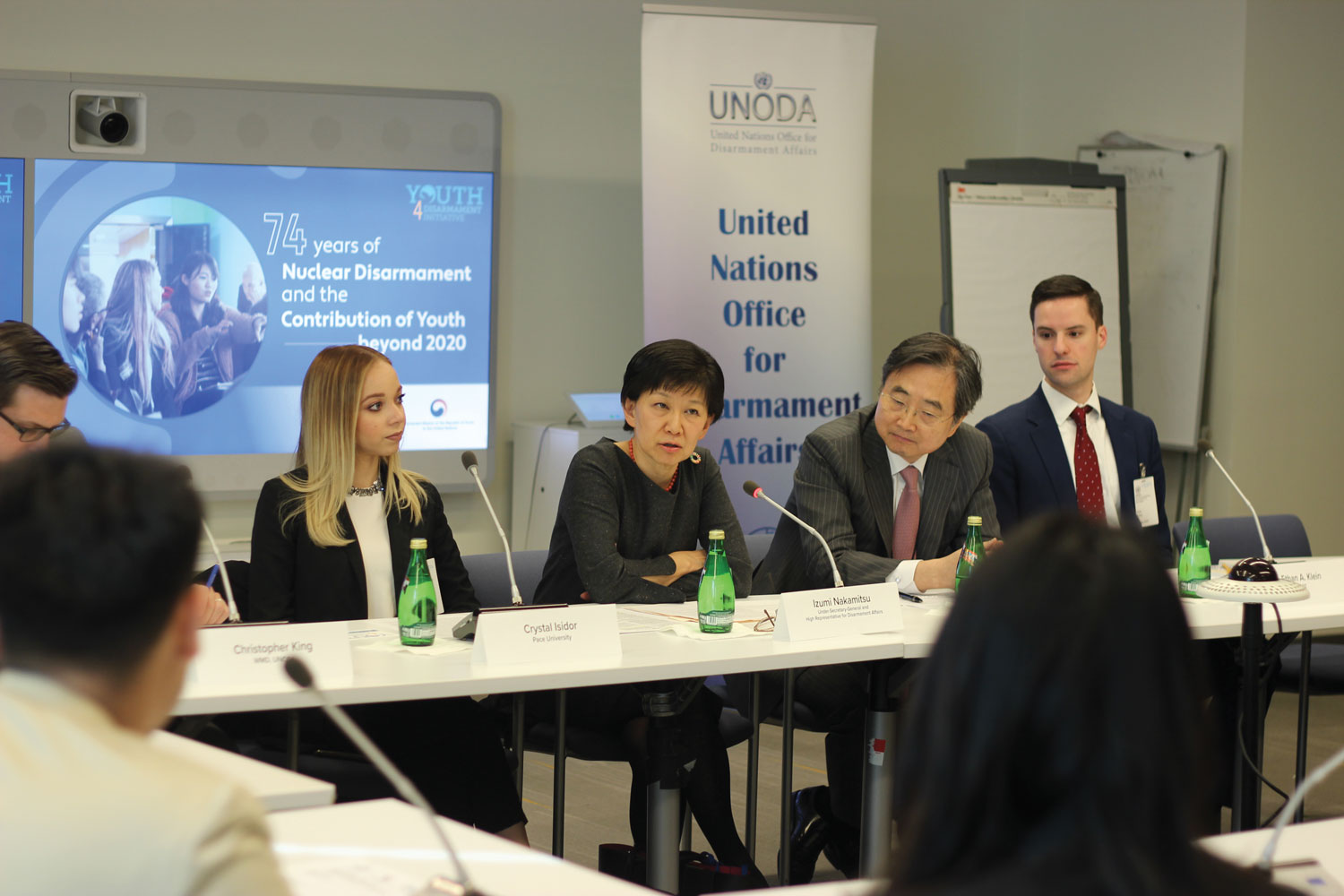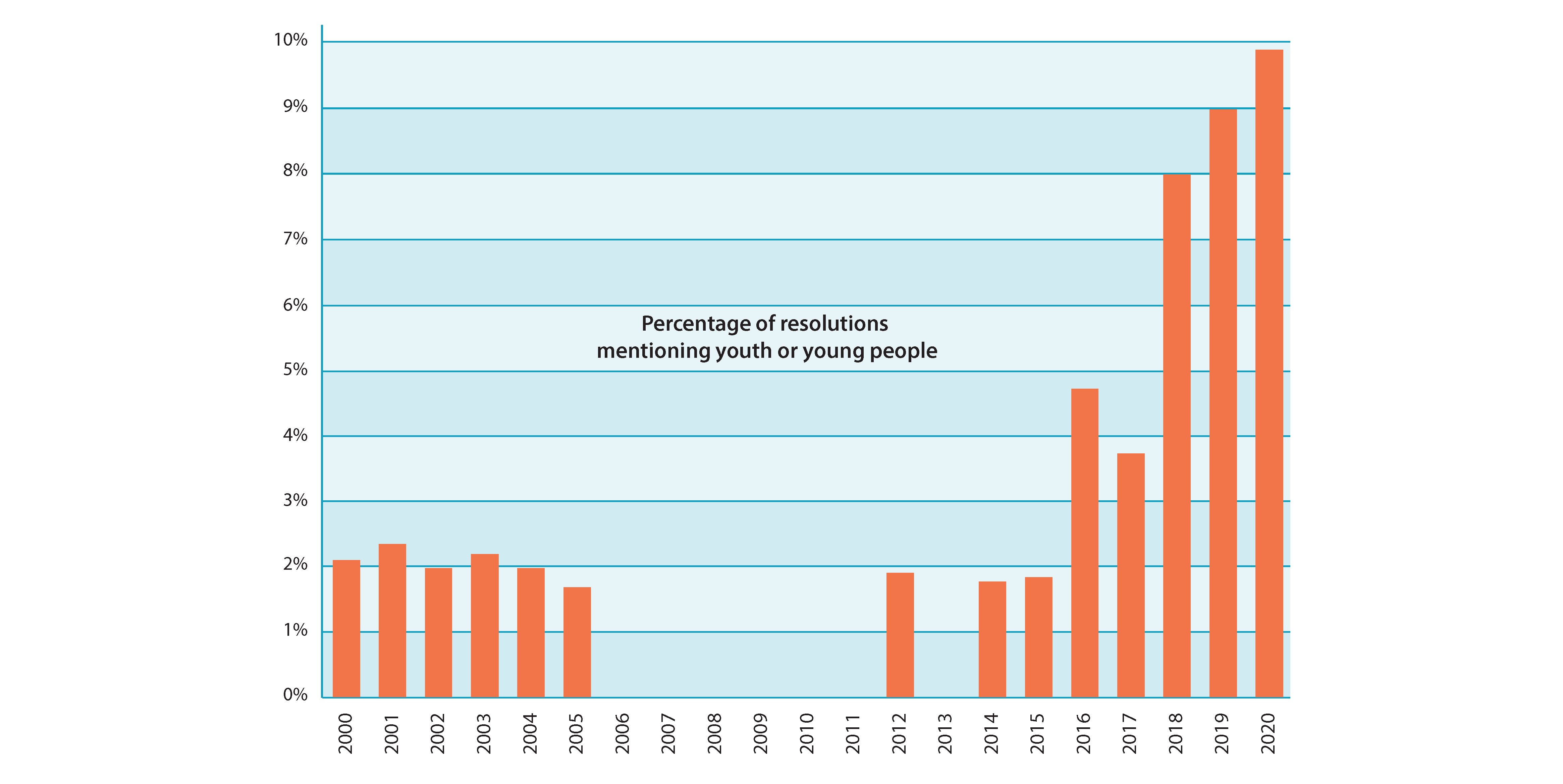I firmly believe that the continued relevance of multilateralism and international cooperation depends on how we create space for young people to fully participate.
In 2020, the General Assembly renewed the two resolutions that form the cornerstone for all United Nations information and outreach activities in the area of disarmament: “United Nations Disarmament Information Programme” (75/80) and “United Nations study on disarmament and non-proliferation education” (75/61). Those mandates underlie efforts by the Office for Disarmament Affairs, and other United Nations entities, to provide Member States, the diplomatic community, non-governmental organizations and the public at large with unbiased, up-to-date and relevant information on multilateral disarmament, non-proliferation and arms control.
For the forty-fourth year in a row since 1976, the Office published the United Nations Disarmament Yearbook, providing a comprehensive account of developments and key issues in the field of disarmament. The 2019 Yearbook included, for the first time, a collection of explanatory graphics and charts, as well as a full chapter on gender issues in disarmament.
In addition, the Office published three titles under its Occasional Papers series during the year: Rethinking Unconstrained Military Spending (No. 35), Conventional Ammunition Management: Developments and Challenges from COVID-19 (No. 36) and the United Nations Programme of Fellowships on Disarmament at 40 (No. 37). Originally conceived in the 1990s to feature, in their entirety, papers or statements made at meetings, symposiums, seminars, workshops or lectures, the Occasional Papers series evolved over the following years to also showcase original work by authors on topical issues in the field of arms limitation, disarmament and international security. While technical and substantive issues are addressed in many of its titles, some from the past decade—including 2020—included historical overviews of activities, issues and subjects deserving of both praise and appraisal.
The Office also produced a new edition of its Civil Society and Disarmament collection, entitled Navigating Disarmament Education: The Peace Boat Model. In the publication, the authors set forth a methodology for disarmament education centred on people-to-people exchanges. They also addressed how such work should be implemented in relation to the 2030 Agenda for Sustainable Development, as well as how digital technologies could be leveraged to provide a rewarding experience for participants.
Meanwhile, the Office for Disarmament Affairs issued several ad hoc publications throughout the year. Those releases included The Militarization of Artificial Intelligence, aimed at examining the benefits of artificial intelligence while mitigating the misapplication of that important technology. The Office also published the Final Report of the UNODA Project to Identify Lessons Learned from the OPCW-UN Joint Investigative Mechanism, containing reflections and recommendations that could benefit future investigations, as well as guidance for confronting the challenges to international peace and security from chemical weapons use. Furthermore, the Office launched the second edition of Aide-Memoire: Options for Reflecting Weapons and Ammunition Management in Decisions of the Security Council. Following the first edition from 2018, the new release contained updates examining the evolution in the Council’s practices related to weapons and ammunition from the late 1990s to August 2020.
In the fourth quarter of 2020, the Office co-published, with Small Arms Survey, Making Room for Improvement: Gender Dimensions of the Life-cycle Management of Ammunition. In that publication—available online in English, French and Spanish—the authors explored how gender considerations could be conceptualized and addressed in the context of the life-cycle management of ammunition. Also in the fourth quarter, the Office published an enhanced version of the Secretary-General’s July 2020 report on current developments in science and technology and their potential impact on international security and disarmament efforts. Including specially designed infographics in the report added a visual dimension to the examination of scientific and technological developments relevant to the means and methods of warfare, as well as of new weapons technologies and their implications.
The Office also issued a new edition in its series Programmes Financed from Voluntary Contributions, covering the period 2019–2020. In the latest volume, the instrumental role of effective partnerships with donors in achieving ambitious disarmament goals was further demonstrated.
The websites of the Office remained a key resource for engagement with delegates, civil society stakeholders and the general public. The “UNODA Meetings Place” website, launched in December 2019, assumed a growing role throughout the year as an all-in-one online location for every disarmament-related meeting supported by the United Nations Secretariat, ending what had been a less efficient practice of creating a new website for every intergovernmental meeting.
In 2020, the Disarmament Yearbook website was launched, making the key findings of the Yearbook available through a dedicated, easy-to-use online resource. Using the new digital platform, visitors could navigate effortlessly through a comprehensive overview of key developments and trends from the previous year in the area of multilateral disarmament, non-proliferation and arms control.
Young people assumed an increasingly prominent role in the work of disarmament during the year, as the Office for Disarmament Affairs undertook various initiatives to further strengthen support for meaningful and inclusive youth participation. Through its “#Youth4Disarmament” initiative, the Office supported the engagement, education and empowerment of young people in disarmament with new resources, including its Open Minds Project e-newsletter; online training programmes; and the new #Youth4Disarmament website, containing career resources, stories from young people and details on upcoming youth-oriented events.

Youth and experts discuss “74 Years of Nuclear Disarmament and the Contribution of Youth Beyond 2020” at an event held in New York on 24 January 2020.
From left: Crystal Isidor, Pace University senior and Model United Nations head delegate; Izumi Nakamitsu, High Representative for Disarmament Affairs; Cho Hyun, Permanent Representative of the Republic of Korea to the United Nations; and Ethan Klein, Ph.D., student at the Department of Nuclear Science and Engineering at the Massachusetts Institute of Technology.
Left: At the event “74 Years of Nuclear Disarmament and the Contribution of Youth Beyond 2020” on 24 January 2020, approximately 70 young people participate in a wide-ranging discussion on youth action for disarmament.
Right: In September 2020, the Office for Disarmament Affairs, with financial support from the Republic of Korea, launched the new #Youth4Disarmament Initiative website to support youth engagement on disarmament. The initiative's explainer video (above) is featured on the website, along with other resources.

After the Security Council unanimously adopted resolution 2250 (2015) on youth, peace and security, the General Assembly increased its number of official references to “youth” or “young people” in resolutions.
The Assembly also expanded the scope of its language in resolutions on youth, moving beyond their participation in educational activities to also recognize their active role and contributions as advocates for disarmament. For instance, in its 2019 resolution on “Youth, disarmament and non-proliferation” (74/64), the General Assembly recognized that “young people in all countries are key agents for social change, economic development and technological innovation”.
Owing to COVID-19 restrictions, the International Day against Nuclear Tests on 29 August was commemorated through a virtual high-level plenary session of the General Assembly, as well as through an online panel discussion organized by the European Forum Alpbach. The International Day for the Total Elimination of Nuclear Weapons was observed on 2 October at a high-level plenary meeting convened by the President of the seventy-fifth session of the General Assembly. The commemorative event took place in line with protocols for in-person meetings during the pandemic, with 112 statements given by Member States and other representatives.
Throughout the year, the Office for Disarmament Affairs made considerable efforts to continue its disarmament information and education efforts despite the complications from COVID-19. By sharing key messages of the High Representative on its website and social media platforms, the Office informed Member States and other stakeholders about how it was remaining active and committed to fulfilling its mandates.
Regarding media outreach, the High Representative published two joint opinion articles—co-authored with senior officials of the United Nations Secretariat, the International Committee of the Red Cross and the Chair of the Secretary-General’s Advisory Board on Disarmament Matters—highlighting actions that Member States and the public could take to address related concerns in a manner consistent with United Nations disarmament goals. In two separate opinion pieces that she authored, the High Representative advocated for modern, multilateral approaches to evolving missile threats, as well as for meaningful inclusion of youth in disarmament activities. Additionally, the High Representative issued a joint call to action with the African Union High Representative for Silencing the Guns, Ramtane Lamamra, encouraging citizens across Africa to hand in their illicit small arms and light weapons in the context of the September 2020 Africa Amnesty Month.